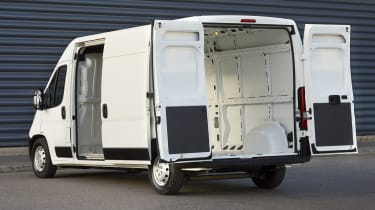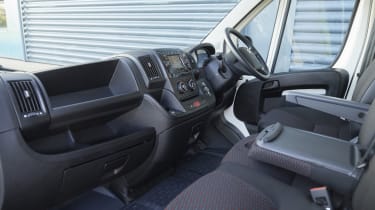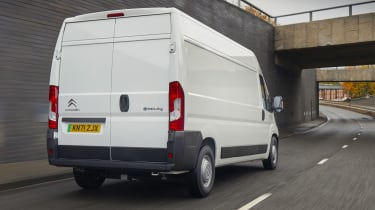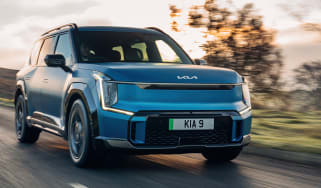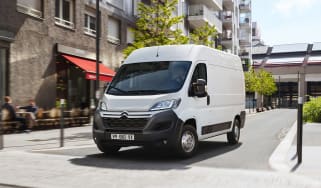Citroen e-Relay review
Despite a choice of body styles and battery packs, Citroen’s largest electric van is a bit too rough around the edges to match the best in this rapidly expanding class
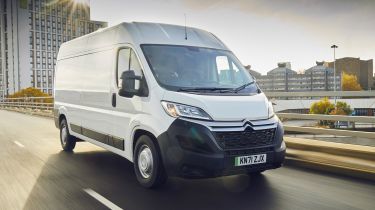
Pros
- Variety of body styles
- 50kW rapid charging
- Good standard equipment
Cons
- Relatively poor range
- Ford E-Transit is cheaper
- Feels like the aftermarket conversion it is
| Model | Range | Wallbox charging time | Maximum cargo volume |
|---|---|---|---|
| 37kWh | 73 miles | 6hrs (0-100%, 7.4kW) | 11.5 cubic metres |
| 75kWh | 154 miles | 12hrs (0-100%, 7.4kW) | 15 cubic metres |
The Citroen e-Relay is the latest large electric van to arrive in dealers, hot on the heels of the Fiat e-Ducato, Renault Master E-TECH and Mercedes eSprinter, not to mention the Ford E-Transit. Like its Peugeot e-Boxer and Vauxhall Movano-e, sister models, however, the e-Relay isn’t fully a product of its rather manufacturer. Rather, bare Relay shells are shipped to a third-party factory in Turkey, where they’re fitted with a 118bhp electric motor and one of the two available battery packs: 37 or 75kWh.
Go for the smaller battery and the e-Relay is only able to cover 73 miles on a charge, while the larger unit offers up to 154 miles of range. Both figures are less than the E-Transit or entry-level e-Ducato can muster. Plus, even though the e-Relay and vans like it are mainly intended for short, last-mile urban-delivery jobs, we expect anyone driving the 37kWh model will feel a bit anxious that they'll have enough range to cover a day's work.
Thankfully, at least the addition of the battery pack hasn't dented the e-Relay's cargo volume. The electrified van comes as a panel van in L2H2, L3H2 and L4H2 sizes; L4H2 window-van and chassis-cab options are available, too. This means there's up to 15 cubic metres of cargo space in the e-Relay, while a payload of up to 1,150kg is possible depending on the version.
The e-Relay does offer 50kW rapid charging, meaning a 0-80% top up can be completed in around an hour from a fast enough charging point. That time applies to both batteries, while the 37kWh unit can be fully charged from a 22kW wallbox in three hours, or six hours from a more common 7.4kW unit. For the 75kWh battery, those times increase to nine hours and 12 hours respectively.
Once you’re inside, the changes made to the e-Relay in the switch from diesel to electric are very obvious. Firstly, there's no gearlever. Instead, you get a blank panel where it used to be, featuring a trio of brushed aluminium push buttons to select Drive, Neutral and Reverse. Another modification can be found down to the right of the steering wheel, where there's now a digital display and buttons for the cabin temperature.
This is because the standard van’s heater is connected to the diesel powertrain, so the e-Relay required a new system. The original controls for the heating are still in place – otherwise there'd be a gaping hole in the centre of the dashboard – and the fan speed and vent controls all still work. It’s only the temperature control that’s substituted for the new display down by the driver's right knee. As a result, passengers can’t control the temperature in the e-Relay, and it’s a fiddly system to operate, but you get used to it.
But more unusual than either of those oddities is the e-Relay’s instruments. It’s the same array of gauges found in the diesel Relay, except that the needles for all but the speedometer have been removed, as the rev counter, fuel gauge and water temperature are obviously no longer required. As opposed to using those dials for any other information the driver might want, Citroen has fitted another digital display into the rear-view mirror that shows the remaining charge in the van’s battery, as well as energy flow.
Get out on the road, and the e-Relay’s relative lack of power is evident as soon as you try to pull away. The 118bhp on tap means everything happens rather sedately, and not a lot happens even with your foot hard to the floor. The throttle response can be a little jerky once you’re moving, too, and there's a constant, tinnitus-like whistle from the electric motor. It’s not altogether that noisy, though; the e-Relay is so much quieter than its diesel-engined counterpart that you can hear the power-steering pump whirring whenever you turn the wheel.

However, the inconsistencies continue with the energy recovery you experience when you back off the throttle. On some occasions the van noticeably starts to slow, while other times it simply coasts. At least the push-button drive selector is easy to use, with the individual buttons for each gear. Reversing in particular is made easier thanks to parking sensors and a beep to warn other road users when you’re manoeuvring the van.
But the e-Relay is lacking when it comes to forward visibility. While the windscreen is vast, your view to either side is hindered by the van's A-pillars and the frames for the quarter-light door glass, which can leave things quite obscured when pulling out of junctions.
Standard kit includes autonomous emergency braking (AEB), hill-start assistance, lane-departure warning, a rear-view camera, reversing sensors, automatic headlights and speed limit recognition. Cruise control is also included, plus blind-spot monitoring and hill-descent control. A five-inch infotainment screen with Bluetooth connectivity is standard as well, while an optional nine-inch screen brings sat nav.
Overall, the Citroen e-Relay is pretty versatile thanks to its choice of battery packs and body styles, and it should serve its likely purpose well as part of a fleet doing last-mile, urban deliveries. But it also feels a bit rough around the edges – despite a starting price of nearly £50,000. As a result of its relatively poor range and the fact that it’s really an aftermarket conversion and not a genuine Citroen product, the e-Relay falls behind the leaders in this class – the Fiat e-Ducato in particular.
That van was developed by Fiat itself, before the Italian brand joined Peugeot, Citroen and Vauxhall in the Stellantis Group. But it’s a better product than the trio’s offerings. It costs about the same, while its electric powertrain is better integrated. Meanwhile, the Ford E-Transit is not only cheaper than the e-Relay, it offers more range, is better to drive and comes with far more technology as standard.

